Got an unwanted ink mark messing up your work or notes? Whether it’s a ballpoint blunder, gel smear, or washable ink mistake, erasing pen marks from paper without damaging the page is tricky—but not impossible.
This guide breaks down the most effective methods to remove pen ink cleanly and compares which tools actually work (and which to avoid).
✅ From craft knives to correction pens, gouache paint to friction-based erasers—this guide has you covered.
Table of Contents
- 1. Why Most DIY Ink Removal Hacks Don’t Work
- 2. How to Remove Pen Ink Using a Razor Blade
- 3. Rubber Ink Erasers (What’s the Best Pen Eraser?)
- 4. Wite-Out Correction Fluid
- 5. Correction Tape
- 6. White Gouache Paint
- 7. Deleter White Ink
- 8. Ink Eraser Pens
- 9. Erasable Pens
- 10. Comparison Table: Best Methods to Erase Pen Ink
- 11. FAQ
- 12. Final Thoughts
1. Why Most DIY Ink Removal Hacks Don’t Work
TikTok loves bleach pens and lemon juice hacks—but most of those ideas end up ruining the paper more than removing the ink.
❌ Avoid using bleach, acetone, or rubbing alcohol. While they might fade ink temporarily, these chemicals break down the paper’s cellulose structure, leading to brittleness and long-term damage. Learn more from conservation experts about how bleach harms paper.
2. How to Remove Pen Ink Using a Razor Blade
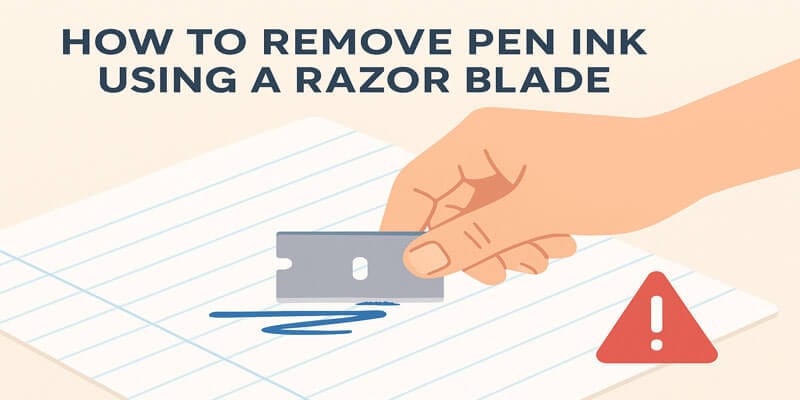
This method works by gently scraping the surface of the paper to lift off the ink. Use a sharp craft knife or razor blade, applying light pressure in small circles.
This is best for ballpoint ink on thicker paper, like card stock. Use caution—overdoing it can easily tear or thin the page.
Want to keep your pens working better, longer? Don’t miss our guide on How to Store Your Pens.
3. Rubber Ink Erasers (What’s the Best Pen Eraser?)
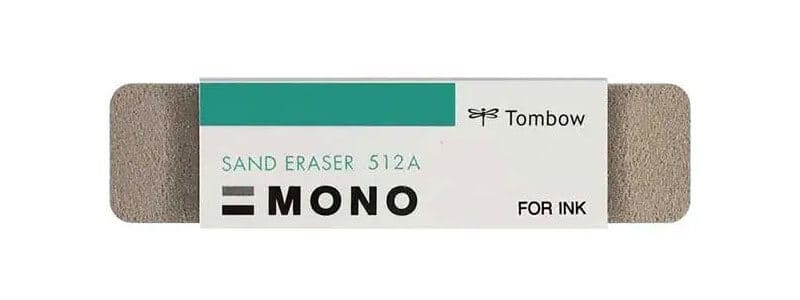
If you’re trying to erase ballpoint pen ink from notebook paper, the Tombow Mono Sand Eraser 512A is one of the best tools available. It’s made from natural rubber latex and silica grit, which gently abrade the surface of the paper to lift ink—without the mess of fluids or tape.
How to Use:
Use short, light strokes and let the eraser do the work. Apply gentle pressure to avoid tearing the paper, especially on thinner sheets.
What Makes It Stand Out:
- Works on ballpoint, rollerball, and colored pencil
- Made from all-natural materials
- Highly rated: ★★★★☆ (4.2 stars on Amazon, 350+ reviews)
- Popular with crafters for removing watercolor smudges, glue residue, and ink
- Endorsed by papercraft expert Jennifer McGuire on YouTube
📌 Tip: It’s particularly effective on cards, standard printer paper, and watercolor paper—but not ideal for thin or textured paper where abrasion may cause damage.
4. Wite-Out Correction Fluid
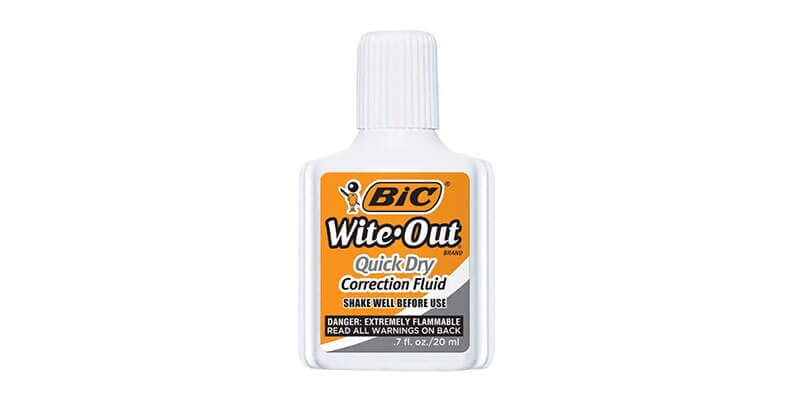
Sometimes, the easiest way to erase pen ink is to cover it completely. Correction fluids like the BIC Wite-Out Shake ‘n Squeeze Correction Pen are designed for just that—creating an opaque layer that hides your mistake and lets you write over it cleanly.
How to Use:
Shake well, then gently squeeze the barrel as you guide the metal tip across the ink mark. Let it dry for 10–30 seconds before writing on top. Best results come on bright white paper and printed forms.
Why It’s So Effective:
- Precision needle tip lets you fix small areas cleanly
- Fast-drying formula prevents smearing
- Trusted brand: BIC is a household name
- Perfect for paperwork, forms, and journals
📌 Tip: Correction fluid isn’t erasing—it’s masking. But it’s one of the most reliable methods for permanent coverage with a pen-like feel.
Related fix: How to Rehydrate a Dried-Out Sharpie
5. Correction Tape
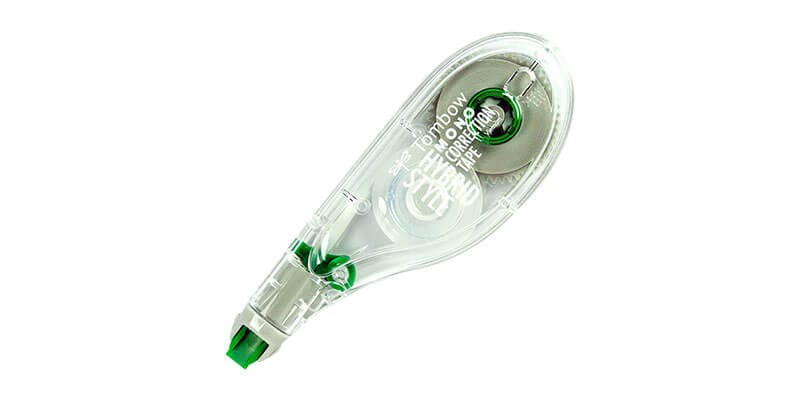
For fast, mess-free ink fixes, correction tape is a game-changer. One of the top-rated options is the Tombow Mono Hybrid-Style Correction Tape, which combines precision and portability in a compact design.
How to Use:
Hold the dispenser at a 45° angle, press gently onto the paper, and swipe across the text you want to cover. That’s it — you can write over it immediately with a pen, pencil, or marker.
Why It’s a Great Choice:
- No drying time, unlike correction fluid
- No smell, drips, or clogging
- Clean, dry finish with no smudging
- Highly rated: ★★★★☆ (4.7 stars from 8,000+ reviews on Amazon)
- Refillable and eco-friendly design (for Hybrid Style)
📌 Tip: It’s perfect for school, office work, or journals where neatness matters — and when you don’t want to wait for fluid to dry.
6. White Gouache Paint
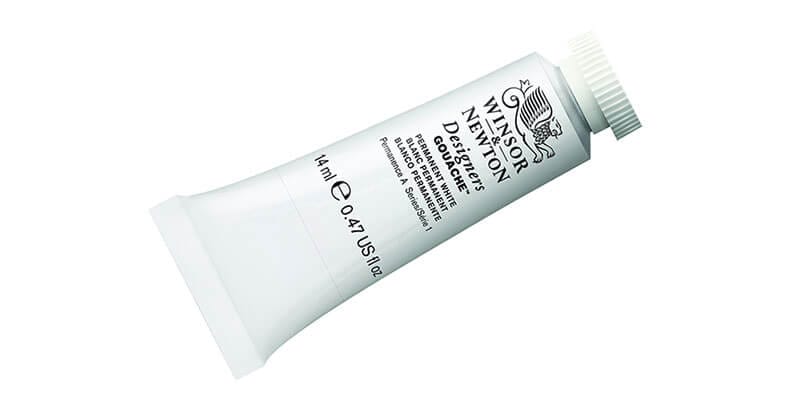
Looking for a clean, artistic way to cover up pen marks? White gouache might be your secret weapon.
Used by illustrators and watercolor artists, gouache is a dense, opaque, water-soluble paint. When applied carefully, it covers ink lines smoothly—and unlike correction fluid, it blends beautifully with paper and can be layered or reworked.
One of the most recommended options is Winsor & Newton Designers Gouache, Permanent White — known for its brightness, smooth texture, and reliability on various paper types.
How to Use:
Apply a small amount with a fine brush directly over the ink. Let it dry completely before writing or drawing over the top. For best results, use on art paper, journals, or sketchbooks.
Why Artists Love It:
- Smoother, more even finish than Wite-Out
- Easy to repaint or layer if needed
- Dries matte — less shine than correction fluid
- Can be used for mistake fixes or intentional highlights
📌 Tip: A little goes a long way—start with a light coat and build up as needed.
Learn more from Winsor & Newton – What Is Gouache?
7. Deleter White Ink
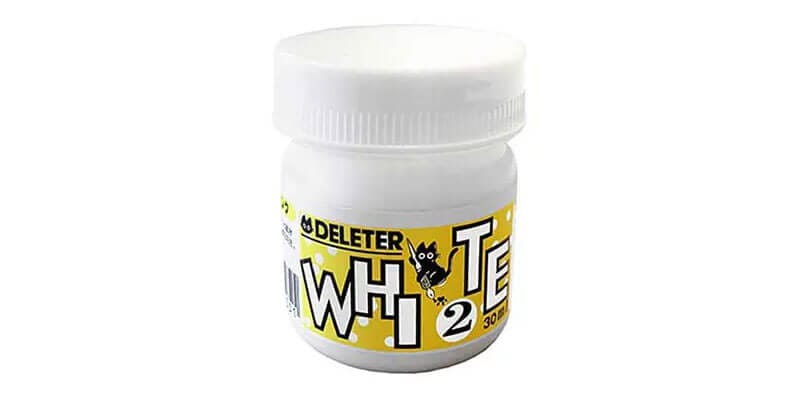
If you’re working with inked artwork—especially fine lines or comic-style illustrations—Deleter White 2 is a professional-grade correction fluid designed specifically for artists.
Unlike traditional correction pens or gouache, this thick, opaque white ink is ideal for layering over black lines and redrawing with precision. It’s widely recommended by comic artists and manga creators for its smooth finish and high coverage.
How to Use:
Apply with a dip pen or fine brush to the area you want to correct. Once dry, you can ink directly over it without the patch being overly visible. It’s best used on smooth, heavyweight art paper.
Why It’s Artist-Approved:
- Ultra-opaque — covers even dense black ink
- Fast-drying, with a paper-like finish
- Works well with dip pens, G-pens, and fine brushes
- Trusted by illustrators and comic professionals
📌 Tip: Shake well before use. This is a true artist’s tool — not your everyday correction fluid.
8. Ink Eraser Pens

Ink eraser pens—also called ink eradicators—are specially designed to erase washable blue ink, most commonly used in fountain pens and school handwriting pens.
One of the most reliable options is the Pelikan Super Pirat Ink Eradicator, which has become a classroom staple across Europe. It works by chemically neutralizing royal blue ink, making it disappear from the page.
How It Works:
Most ink eraser pens are dual-tipped:
- One end has a chisel tip eraser to erase washable ink
- The other has a fine tip blue pen to write over the erased area with permanent royal blue ink
This system allows students and writers to correct mistakes neatly—without needing correction fluid or tape.
Compatible Inks and Pens:
- Washable blue inks like Diamine Washable Blue or Parker Quink
- Handwriting pens such as Berol Handwriting Pen and Stabilo EASYoriginal
📌 Note: You can’t reuse washable ink over the same spot—residue from the ink eradicator will cause it to react and fade again.
Also handy: How to Rehydrate a Dried-Out Sharpie
9. Erasable Pens
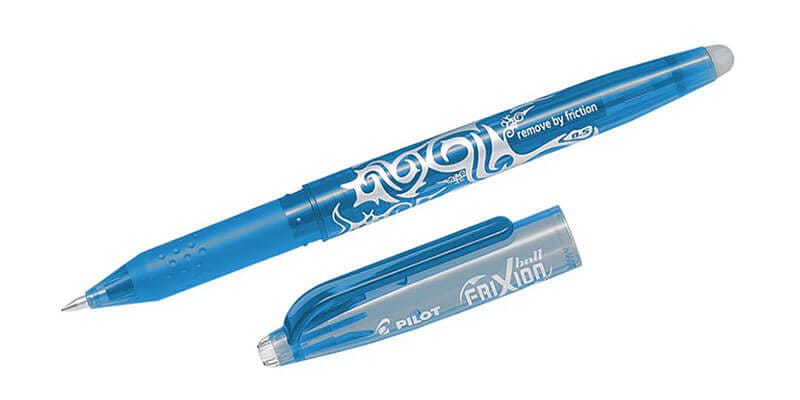
One of the easiest and cleanest ways to fix writing mistakes? Don’t erase them—prevent them with erasable ink.
Pilot FriXion pens have become the gold standard in erasable writing tools. They use thermosensitive ink that disappears when you rub it with the built-in eraser tip. The friction generates just enough heat to make the ink vanish like magic—no mess, no smearing.
Best for:
- Bullet journals and planners
- Note-taking and test prep
- Everyday handwriting for students, teachers, and office work
Once erased, you can write directly over the area, and there’s no residue or smudging.
📌 Heads up: If you leave your notebook in a hot car, the ink could fade away. You can restore it by placing the paper in the freezer—but it’s best to avoid heat-sensitive situations.
Want to know which erasable pens are best for writing, drawing, fabric, or planners? Check out The Complete Guide to Erasable Pens for a full breakdown of the top options by category and ink type.
Curious about the science behind them? Discover how erasable pens work in Pilot Pen’s official explanation or dive deeper into the history and chemistry of erasable ink.
[Insert Image: Pilot FriXion Pen]
10. Comparison Table: Best Methods to Erase Pen Ink
Here’s a side-by-side look at popular pen ink erasing tools, what they’re best for, and their pros and cons:
| Method | Erases Ink | Paper Damage | Visibility | Best For |
|---|---|---|---|---|
| Razor Blade | ✅ High | ⚠️ High | ❌ Obvious | Emergency fixes on tough paper |
| Tombow Sand Eraser | ✅ Medium | ✅ Low | ✅ Clean | Ballpoint on notebook paper |
| BIC Wite-Out Fluid | ❌ Covers | ✅ Low | ❌ Visible | Quick fixes on printed documents |
| Correction Tape | ❌ Covers | ✅ Low | ✅ Neat | Lined or typed documents |
| White Gouache Paint | ❌ Covers | ✅ Low | ✅ Subtle | Artists, illustrations |
| Deleter White Ink | ❌ Covers | ✅ Low | ✅ Sharp | Fine-line art and comics |
| Pelikan Ink Eraser | ✅ Targeted | ✅ None | ✅ Clean | Washable blue ink on school paper |
| Pilot FriXion Pens | ✅ Built-in | ✅ None | ✅ Clean | Journals, notes, planners |
11. FAQ
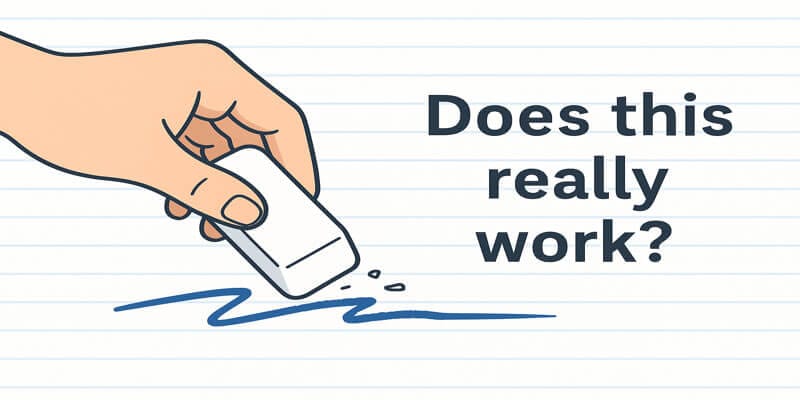
Does whiteout ruin the paper?
Not usually, but it can crack or peel over time, especially on thin or glossy paper.
What’s the best way to remove pen ink from notebook paper?
Use the Tombow Mono Sand Eraser or a precision blade. They’re less likely to damage thin pages.
Can I use rubbing alcohol or bleach?
❌ Avoid using bleach or acetone. While they may lighten ink, they also damage the cellulose in paper and weaken its structure over time. Learn more about how bleach degrades paper.
How do artists fix ink mistakes?
White gouache or Deleter White applied with a fine brush lets them hide small errors with precision.
More info: Winsor & Newton – What Is Gouache?
Do Pilot FriXion pens really erase?
Yes! They use heat-sensitive ink that vanishes when rubbed with the built-in eraser tip. The friction generates heat, which causes the ink to become invisible — no smudging, no residue.
Learn more about how FriXion ink works from Pilot Pen.
What’s the difference between erasable pens and ink erasers?
Erasable pens are designed to be removed by friction, while ink erasers chemically lift specific types of ink (usually washable blues).
Explore the science of erasable pens
Are erasable pens good for school or exams?
They’re great for notes and homework but not recommended for exams — heat can erase your answers, and some schools ban them for that reason.
12. Final Thoughts
Erasing pen ink cleanly comes down to choosing the right method for your specific needs.
- For everyday writing or ballpoint slips, a Tombow Mono Sand Eraser or even a carefully used razor blade works well on standard paper.
- For artwork or precise corrections, white gouache or Deleter White Ink offers opaque, seamless fixes without ruining your sketch.
- If you want to stop mistakes before they happen, erasable pens like the Pilot FriXion series are a smart, mess-free option—just keep them out of hot environments, or your notes may vanish!
Before you go: make sure you’re storing your pens properly to extend their life and avoid ink mishaps.
→ How to Store Your Pens

You can use sandpaper with a fine grit to buff off the ink or use whiteout or ink-correction tape to cover
Thanks for the detailed information.
Please tell me where to find an erasable pen in south Africa
Hobby Lobby